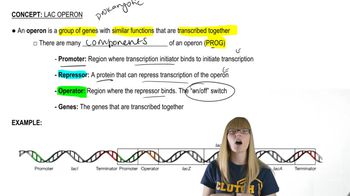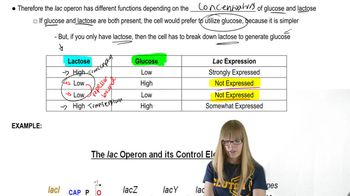Table of contents
- 1. Introduction to Genetics51m
- 2. Mendel's Laws of Inheritance3h 37m
- 3. Extensions to Mendelian Inheritance2h 41m
- 4. Genetic Mapping and Linkage2h 28m
- 5. Genetics of Bacteria and Viruses1h 21m
- 6. Chromosomal Variation1h 48m
- 7. DNA and Chromosome Structure56m
- 8. DNA Replication1h 10m
- 9. Mitosis and Meiosis1h 34m
- 10. Transcription1h 0m
- 11. Translation58m
- 12. Gene Regulation in Prokaryotes1h 19m
- 13. Gene Regulation in Eukaryotes44m
- 14. Genetic Control of Development44m
- 15. Genomes and Genomics1h 50m
- 16. Transposable Elements47m
- 17. Mutation, Repair, and Recombination1h 6m
- 18. Molecular Genetic Tools19m
- 19. Cancer Genetics29m
- 20. Quantitative Genetics1h 26m
- 21. Population Genetics50m
- 22. Evolutionary Genetics29m
12. Gene Regulation in Prokaryotes
Lac Operon
Problem 17h
Textbook Question
Textbook QuestionKeeping in mind the life cycle of bacteriophages discussed earlier in the text (see Chapter 6), consider the following problem: During the reproductive cycle of a temperate bacteriophage, the viral DNA inserts into the bacterial chromosome where the resultant prophage behaves much like a Trojan horse. It can remain quiescent, or it can become lytic and initiate a burst of progeny viruses. Several operons maintain the prophage state by interacting with a repressor that keeps the lytic cycle in check. Insults (ultraviolet light, for example) to the bacterial cell lead to a partial breakdown of the repressor, which in turn causes the production of enzymes involved in the lytic cycle. As stated in this simple form, would you consider this system of regulation to be operating under positive or negative control?
 Verified Solution
Verified SolutionThis video solution was recommended by our tutors as helpful for the problem above
Video duration:
48sPlay a video:
393
views
Was this helpful?



